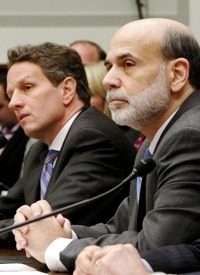
Claims that cabals of “banksters” control much of the world’s economy from behind closed doors have, for years now, been mainstays of those usually dismissed as “conspiracy theorists.” But since Fall 2008, which saw billions funneled into banking and other institutions deemed “too big to fail,” and since hundreds of billions remain unaccounted for; and especially since the Federal Reserve has successfully resisted efforts to make its activities more transparent — especially its dealings with foreign banks — such claims have gained both visibility and at least some credibility.
While not exactly pointing fingers at the Rothschild-Rockefeller axis, a Congressional hearing last week made it clear that a culture of secrecy pervaded the Federal Reserve Bank of New York during that period.
Bloomberg.com recently reported on the hearing, convened to investigate the bailout of American International Group Inc. (AIG), the insurance giant. Revelations from that meeting include behind-closed-doors activities which funneled billions of dollars to favored banks, with no Congressional or other oversight.
Revealed was that in November 2008, the Federal Reserve Bank of New York used $30 billion to buy out insurance contracts AIG sold on toxic debt securities to several of the largest banks, including Goldman Sachs and Merrill Lynch in the U.S. and Societe Generale and Deutsche Bank AG in Europe, among others. The banks received 100 cents on the dollar for contracts that would have been considerably less if AIG had been allowed to fail.
Timothy Geithner, now U.S. Treasury Secretary, was at the helm of the Federal Reserve Bank of New York at the time. Geithner continued to maintain that the collapse of AIG would have threatened a financial Armageddon.
Both Federal Reserve Chair Ben Bernanke (just reappointed to a second four-year term) and former U.S. Treasury Secretary Henry Paulson denied involvement in the bank bailouts. Geithner said he had recused himself following his November 24 appointment to then-President-Elect Obama’s cabinet. In that case, who was in charge?
It appears as if New York Fed staffers and outside lawyers had hoped to thwart the efforts of Congress to gain access to details of the purchase of the toxic assets, known as credit default swaps. One staffer, James Bergin, sent out an email reading, “I have to think this train is probably going to leave the station soon an we need to focus our efforts on explaining the story as best we can. There were too many people involved in the deals — too many counterparties, too many lawyers and advisors, too many people from AIG — to keep a determined Congress from the information.” In other words, given our inability to keep Congress in the dark, let us prepare to do whatever damage control is necessary.
The Federal Reserve’s Board of Governors oversees twelve Federal Reserve Banks, including the New York Fed. These twelve banks, quasi-governmental entities, are appointed by boards, whose members are further appointed mostly by other bankers. There is very little accountability to Congress or the public even as the bankers make decisions to lend and guarantee trillions to prop up the financial system—trillions that taxpayers are expected to cover. On the other hand, there is abundant evidence that those on the inside will try to cover their tracks.
Small wonder that outside observers get the impression that a cabal of upper-echelon “banksters” owns and controls the financial life of this country, operating through the Federal Reserve system.
Photo of Treasury Secretary Timothy Geithner, Federal Reserve Chairman Ben Bernanke: AP Images



